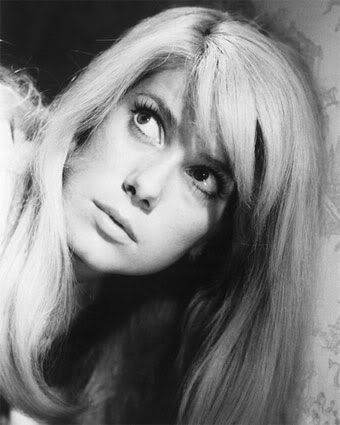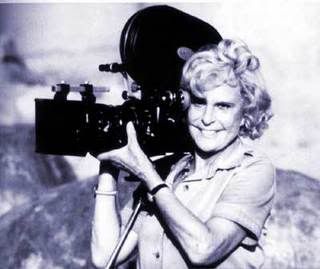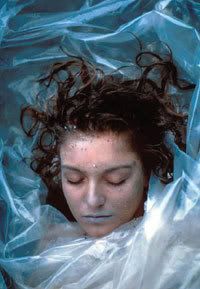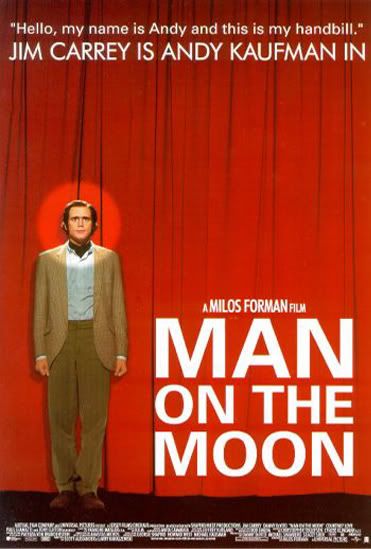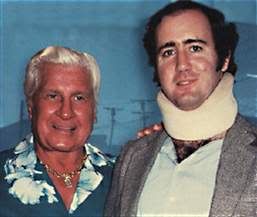Lessee now...bio-pics about filmmakers. I dunno what took
moviemakers so long to get around to attacking this subject---doesn't make sense, given how they make their lettuce. But as far as I can tell, Clint Eastwood's 1990 film
White Hunter, Black Heart seems to have come first, surprisingly enough. It may have cloaked its main character with the name "John Wilson," but it obviously and effectively tells the brutal story of John Huston and his exploits while making
The African Queen. Then we have Richard
Attenborough's stuffy 1992 recounting of the life of
Chaplin, with its only memorable element being Robert
Downey Jr.'s dead-on performance as the film pioneer. But the best of the bunch, before or since, is Tim Burton's comically inventive version of the life of the greatest Z-list
moviemaker of all time. What would've Ed Wood himself thought about
Ed Wood? He would've eaten it up like a thick steak and downed it all with a fifth of scotch.
I'll never forget seeing
Ed Wood for the first time, at 10:30 on a Sunday night in Atlanta, at Phipps Plaza. Not many people in the audience--the film was a bigger hit on video/DVD than at the theaters. That was okay by me--that meant less people talking in the theater. But from their rapt attention, I knew this crowd knew and appreciated Ed Wood the man. And from that first shot pulling into a rain-battered house that hides a coffin containing
Criswell (Jeffrey Jones), who rises and proceeds to introduce this film in the same manner that the real
Criswell introduced
Plan 9 From Outer Space--this
thunderstruck concept had its hooks in me, and I had no worries. I knew we were all in for a good time. Further, when Howard Shore's masterful, bongo-and-
theremin-driven score blares forth, and the inventively orchestrated credits sequence carries us through an
Woodian cemetery, a fight with a giant octopus, and a trip into outer space--I REALLY knew I was in for
transcendence. And the show had barely started.
Face it: Edward D. Wood Jr. made movies the way he wanted to make them. He had twisted visions and technique, and not a dime, and it didn't matter, '
cuz people are still watching
Plan 9 From Outer Space, Bride of the Monster, Glen or Glenda, and
Jailbait.
Ed Wood is easily Tim Burton's greatest movie, and one of the greatest movies about the movies, because it knows this. It realizes the singularity of his efforts and boldly makes a direct correlation between Wood, who made the "worst" movies of all time and Orson Welles, who made the "best." On top of that, the film's special
luminescence comes from the clever irony seeing Burton's opulent, expensive black-and-white work, gorgeously produced and paced, about a guy who made perfectly ugly black-and-white
el cheapos that still, because of their naive, even sloppy uniqueness, hold us in their thrall.
In what is still also their best work, pop culture chroniclers/ screenwriters Scott Alexander and Larry
Karazewski (
Man on the Moon--about Andy Kaufman--and
Auto Focus--about Bob Crane) found a sapphire of inspiration in their exploration of the creative urge and the joy in following a dream, however whacked-out it may be.
Ed Wood exudes a romance for
filmmaking, maybe for the first time in cinema history; it loves the process. Rich in character--and in characters (Jones'
Criswell, George "The Animal" Steele's Tor Johnson, Lisa Marie's
Vampira, Bill Murray's Bunny
Breckinridge, and the
incomparable Martin Landau,
unrecognizable in Rick Baker and Ve Neill's deft makeup, as Bela Lugosi), Ed Wood's life now seems made for cinematic retelling (the film is based on Rudolph Gray's verbal history book,
Nightmare of Ecstasy). Even if Wood's (and Lugosi's) time on earth weren't as peachy as it appears here, it's okay--for me, that's part of the movie's cosmic joke: it's a $25 million Hollywood movie about an off-Hollywood director who was probably lucky to make 25 million cents in his lifetime.
Even with its love-lettering to movies, the decision to center the work on the father-son relationship between the optimistic Wood and the morphine-addicted Lugosi is a masterstroke, particularly coming from Burton. He had a
similar relationship with his own boyhood idol, Vincent Price, who was not only the subject and narrator of Burton's first animated success, the likely autobiographical
Vincent, but also, in his final screen role, played a key part in Burton's
Edward Scissorhands. It stands, then, that this odd, touching on-screen fellowship between Johnny
Depp's always-
firey Wood and Landau's alternately sluggish and sharp Lugosi resonates throughout the film, even after Lugosi has disappeared from the scene. Both performances ended up being the single best special effect of 1994, a spinning wheel of desperate ego and deflated despair, all spiced up with Landau's grouch
iness and
Depp's emboldened zeal.
Depp's showing here, after his uniformly touching displays of talent in
Edward Scissorhands, What's Eating Gilbert Grape and
Benny and Joon, convinced me that he was the finest male performer of his era.
As for the supporting cast, Murray scores points for delivering some of the movie's funniest moments, including its best throwaway gag--he dips a
sneakered toe into a baptismal pool to "check" its temperature. Sarah Jessica Parker is an appropriately shrill presence as Ed Wood's first girlfriend and ill-fated leading lady (who went on to bigger things as the writer of a few Elvis Presley songs), while Patricia
Arquette effuses wonderful sweetness as Wood's understanding true love (she barely reacts to Wood's nervous confession of compulsive
tranvesticism). And Vincent
D'Onofrio cameos brilliantly with his exacting imitation of Orson Welles (which is strangely looped in its sound--an element I like to view as a tribute to Welles' largely sound looped work in
Touch of Evil). I also like Rance Howard (Ron Howard's dad) as the demanding producer of
Bride of the Monster, with his emphatic desire that the film end with a "
biiiiiiiig explo-
sion!" Mike Starr's confused, streetwise backer of
Glen or Glenda? is also a blustery notation.
However, Martin Landau is the miracle worker among them all. I still remember being introduced to him with
Space:1999, the often maligned but strangely, quietly entertaining 1970s science fiction show from Britain's
Thunderbirds producers Gerry and Sylvia Anderson. If you would've told me when I was 13 that he'd take home an Oscar in twenty years for playing Lugosi, I woulda laughed in your face, even while knowing of his contributions to such films as
North By Northwest and
Cleopatra. But, starting with Coppola's
Tucker: The Man and His Dream and on into Woody Allen's
Crimes and Misdemeanors, Landau
was obviously on to a superior second wind. I mean, is there anything funnier than the scene where Lugosi is charged with stepping into a night-shrouded pond ("Damn, it's cold! Throw me the viskey!!") in order to fake a life-or-death struggle with a giant, dead-tentacled fake octopus? His screams as he writhes with this thing are the stuff of myth, and the camera crew doesn't even have sound! By scene's end, the shot of an awed Ed Wood saying "That was perfect!" is completely called-for. And, in another key sequence, the way Landau's drugged-up Lugosi begs to end his life--with Wood in tow for the ride--and then grabs ahold of himself, eyes aglow, and breaks down in Eddie's arms, apologizing for even considering the notion. Wow. I didn't expect to
cry in this movie. But I did.
Finally, as if all this
weren't enough to convince one of
Ed Wood's merits (and some people might still need convincing, since the film's cult status was confirmed by its sadly low $6 million box office take), the movie boasted of some indespensible technical contributions: Shore's moving and detailed score, Stefan
Czapky's award-winning, contrasty black-and-white photography, Tom Duffield's appropriately seedy art direction, and Colleen Atwood's imaginative costume design. With the exception of his gloriously silly
Pee-Wee's Big Adventure, Beetlejuice, and
Edward Scissorhands (each of which were nearly equal in quality to
Ed Wood), I had always thought that Tim Burton had a genius for creating deeply-flawed but quite watchable films (his subsequent output, with the exception of the charming
Big Fish and ambitious
Sweeney Todd, has been much less impressive, with the outrageously puzzling and derivative
Planet of the Apes, Sleepy Hollow,
Charlie and the Chocolate Factory, and on and on, with the diminishing returns of
Alice in Wonderland and
Dark Shadows). But he vindicated himself, forever and entirely, with this heartfelt comedic masterpiece
Ed Wood. I like to think that Burton is constantly striving to make this kind of movie once again.

